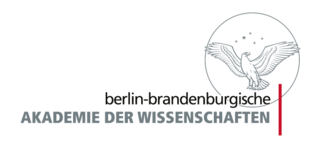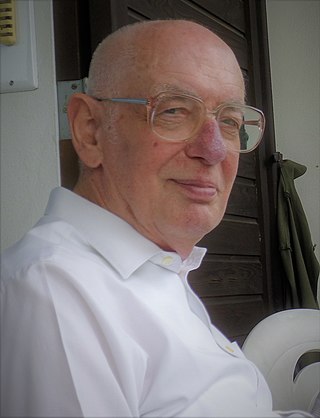
Christian Gottfried Ehrenberg was a German naturalist, zoologist, botanist, comparative anatomist, geologist, and microscopist. He is considered to be one of the most famous and productive scientists of his time.

The Leibniz Association is a union of German non-university research institutes from various disciplines.

The Berlin Observatory is a German astronomical institution with a series of observatories and related organizations in and around the city of Berlin in Germany, starting from the 18th century. It has its origins in 1700 when Gottfried Leibniz initiated the "Brandenburg Society of Science″ which would later (1744) become the Prussian Academy of Sciences. The Society had no observatory but nevertheless an astronomer, Gottfried Kirch, who observed from a private observatory in Berlin. A first small observatory was furnished in 1711, financing itself by calendrical computations.

The Berlin-Brandenburg capital region is one of the most prolific centers of higher education and research in the world. It is the largest concentration of universities and colleges in Germany. The city has four public research universities and 27 private, professional and technical colleges (Hochschulen), offering a wide range of disciplines. Access to the German university system is tuition free.

The Royal Prussian Academy of Sciences was an academy established in Berlin, Germany on 11 July 1700, four years after the Prussian Academy of Arts, or "Arts Academy," to which "Berlin Academy" may also refer. In the 18th century, when French was the language of science and culture, it was a French-language institution.
Akademie Verlag (AV) is a German scientific and academic publishing company, founded in 1946 in the Soviet-occupied eastern part of divided Berlin to facilitate the publication of works by and for the German Academy of Sciences Berlin.
Justus Mühlenpfordt was a German nuclear physicist. He received his doctorate from the Technische Hochschule Carolo-Wilhelmina zu Braunschweig, in 1936. He then worked in Gustav Hertz's laboratory at Siemens. In 1945, he was sent to Institute G, near Sukhumi and under the directorship of Hertz, to work on the Soviet atomic bomb project. Released from Soviet Union, Mühlenpfordt arrived in East Germany in 1955. He was appointed director of the Institut für physikalische Stofftrennung of the Academy of Sciences, in Leipzig. From 1969 until his retirement in 1974, Mühlenpfordt was director of the Forschungsbereiches Kern- und Isotopentechnik der Akademie.

The Berlin-Brandenburg Academy of Sciences and Humanities, abbreviated BBAW, is the official academic society for the natural sciences and humanities for the German states of Berlin and Brandenburg. Housed in three locations in and around Berlin, Germany, the BBAW is the largest non-university humanities research institute in the region.
The Berlin-Brandenburg Academy Award by the Berlin-Brandenburg Academy of Sciences and Humanities is a annually science prize worth 30,000 euros. It is awarded to a "distinguished scientist whose research achievements have opened new and promising lines of research." The prize is given for outstanding scientific achievements in the fields of humanities and social sciences, mathematics and natural sciences, life sciences and medicine, and engineering sciences. The award ceremony coincides with a Leibniztag plenary lecture in commemoration of Gottfried Leibniz, in which the award winner describes his or her research.
Helmut Schwarz is a German organic chemist. He has been a professor of chemistry at the Technische Universität Berlin since 1978. In 2018, he was elected a foreign associate of the U.S. National Academy of Sciences.
Annette Zippelius is a German physicist at the University of Göttingen. In 1998 she became a Gottfried Wilhelm Leibniz Prize winner. Her research focuses on complex fluids and soft matter – materials that are intermediate between conventional liquids and solids. Examples are glasses, polymeric melts or solutions, gels and foams, but also granular matter. With her research group she aims at elucidating the underlying principles of self-organization that govern their behavior.
Werner Scheler was a German physician and pharmacologist.
Karl-Wolfgang Zschiesche was a German physician and pathologist.
Marina V. Rodnina is a German biochemist.

Lieselott Herforth was a German physicist and politician. She was a member of the State Council and the People's Chamber of the GDR and she was the first rector of a university in Germany.

Peter Heinz Feist was a German art historian.

Dieter Bernhard Herrmann was a German historian of astronomy and author of numerous popular science books on astronomy. He was director of the Zeiss Major Planetarium in Berlin from 1987 to 2004. In his scientific work he dealt with the early development of astrophysics and the application of quantitative methods in the history of science.
Joachim Herrmann was a German historian, archaeologist, scientist, and institutional director. He was a noted scholar in East Germany (GDR) who specialized in Slavic archaeology, but with ambivalent legacy, as his career and research was politically motivated because of which he "deliberately distorted the view of history".

Helga Schultz was a German historian whose work focused on the economic and social history of Europe.

The Leibniz-Sozietät der Wissenschaften zu Berlin is a German-speaking association of scientists founded in Berlin in 1993 in the legal form of a registered association. It is dedicated to interdisciplinary and transdisciplinary exchange and the discussion of fundamental problems in science and society. The association continues the activities of the Academy of Sciences of the GDR with personnel continuity.











